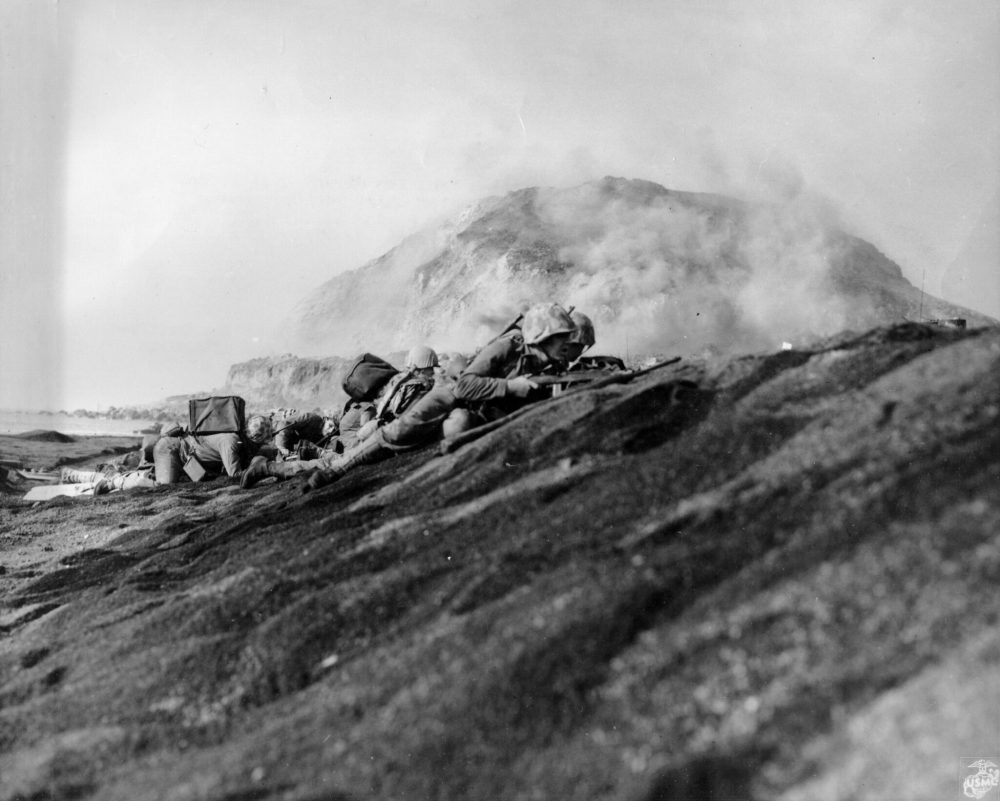
“Iwo Jima: Another Wave Moves In,” as captioned by the U.S. Marine Corps Archives, showing M-1 Carbine-armed Marines taking cover behind slopes of soft black volcanic ash on the beach. Movement on it was described as “trying to run in loose coffee grounds.” The battle for Iwo Jima would last for six weeks, from Feb. 16 to Mar. 26, 1945. (Photos: USMC Archives/U.S. Naval History and Heritage Command.)
Some 75 years ago today, 60,000 U.S. troops began a campaign to seize an 8 square mile pork chop-shaped island none of them had likely heard of before– Iwo Jima. Soon, they would never forget it.
Dominated by Mount Suribachi, a dormant volcano, Iwo Jima in February 1945 was an important and strategic steppingstone to the ultimate invasion of Japan during World War II. At three airfields built on the volcanic ash, American B-29 bombers could make emergency landings and escorting P-51 Mustang fighters based there could sortie to the Japanese Home Islands, putting the Empire squarely under the bombsights of the world’s most powerful air force.
Defending the fortress was Gen. Tadamichi Kuribayashi’s forces, which had largely evacuated the civilian population on Iwo and has spent months preparing the island’s difficult terrain to best resist the amphibious assault. They dug 16 miles of tunnels, broken up into 1,500 different bunkers, underneath the island.
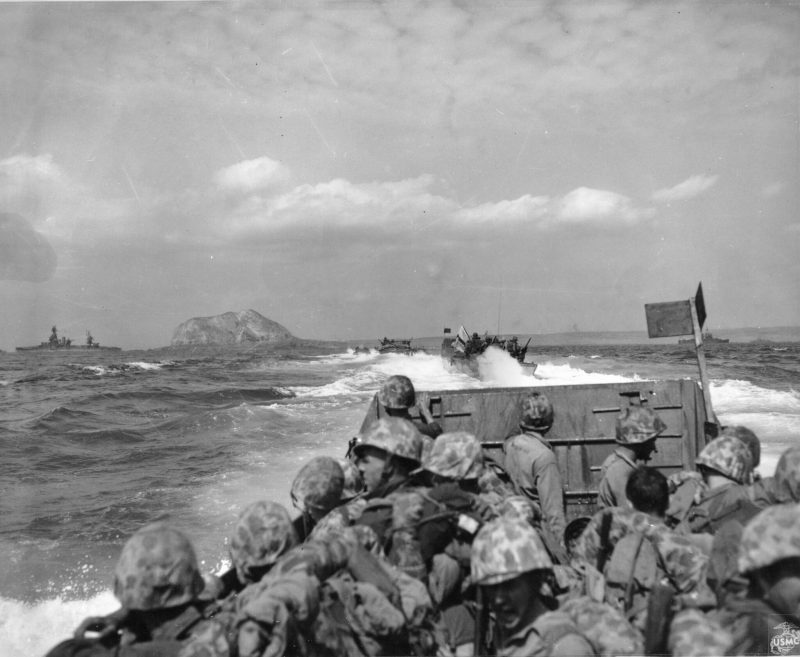
U.S. Marines Iwo Jima bound, Feb. 19, 1945.
On February 19, after three days of naval and air bombardment, the V Amphibious Corps, spearheaded by the 4th and 5th Marine Divisions, hit Red Beach and Green Beach and soon found themselves the subject of intense Japanese mortar and sniper fire. Over the next six weeks, as the Marines clawed their way into the interior of Iwo Jima and eventually planted the U.S. flag on Mount Suribachi, the combat would only get worse.
For many Marines, their most common infantry arm was the .30 Caliber M1 Carbine or the larger M1 Garand, the latter chambered in .30-06 Springfield.
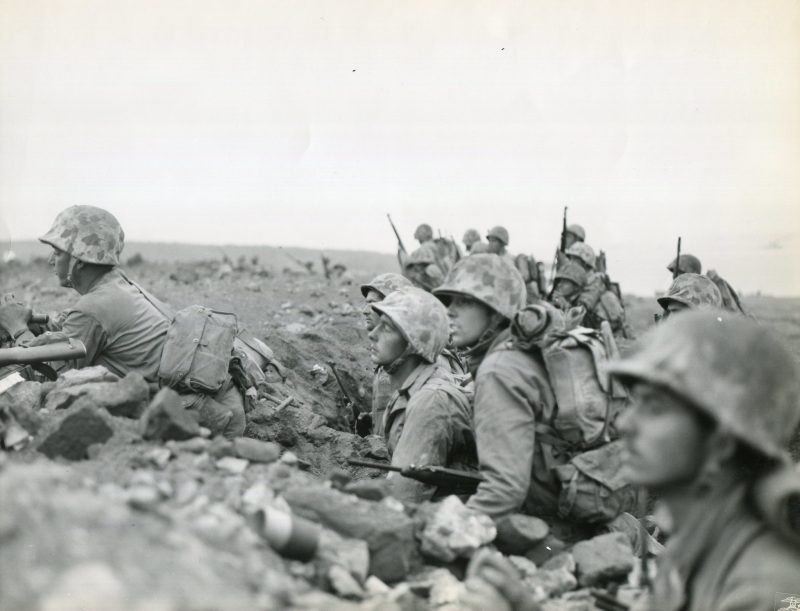
“FORMED—- Organized and formed for the assault, Marines of one of the Regiments of the Fourth Marine Division under Major General Clifton B. Cates, USMC, are ready to attack the enemy-held Motoyama Airfield Number One, on Iwo Jima, 500 yards inland from the beach.” Note the Marines in the foreground with M1 Carbines and the unmistakable profile of M1 Garands in the distance.
The M1 Garand, developed by Springfield Armory and adopted by the U.S. Army in 1936, only became a Marine rifle later in WWII. The Marines famously fought their early campaigns on Guadalcanal with the bolt-action M1903 Springfield rifle while elite units like the Marine Raiders and Paramarines were augmented with more exotic platforms such as the Reising submachine gun and M1941 Johnson.
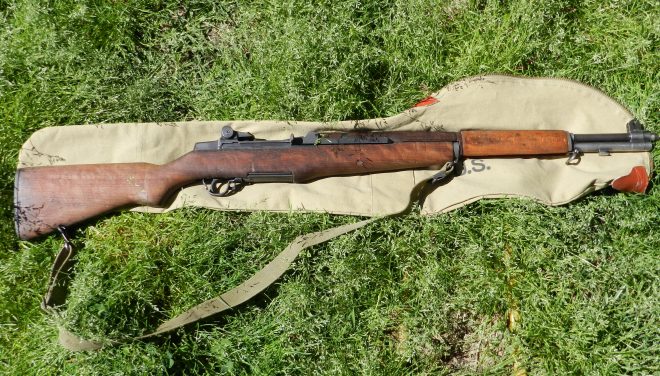
The 9.5-pound Garand, officially ” U.S. rifle, caliber .30, M1″ had a 24-inch barrel and wooden furniture. They cost the Army about $85 to produce during WWII and remained the standard American military rifle until the select-fire M14 came along in 1957. (Photo: Chris Eger/Guns.com)
The more compact M1 Carbine, a “war baby” that only entered production seven months after the attack on Pearl Harbor, was lightweight, at just over 5-pounds. With more than 6 million cranked out by companies as diverse as Inland, Winchester, Saginaw, and IBM, it was one of the more common individual American weapons of the conflict.
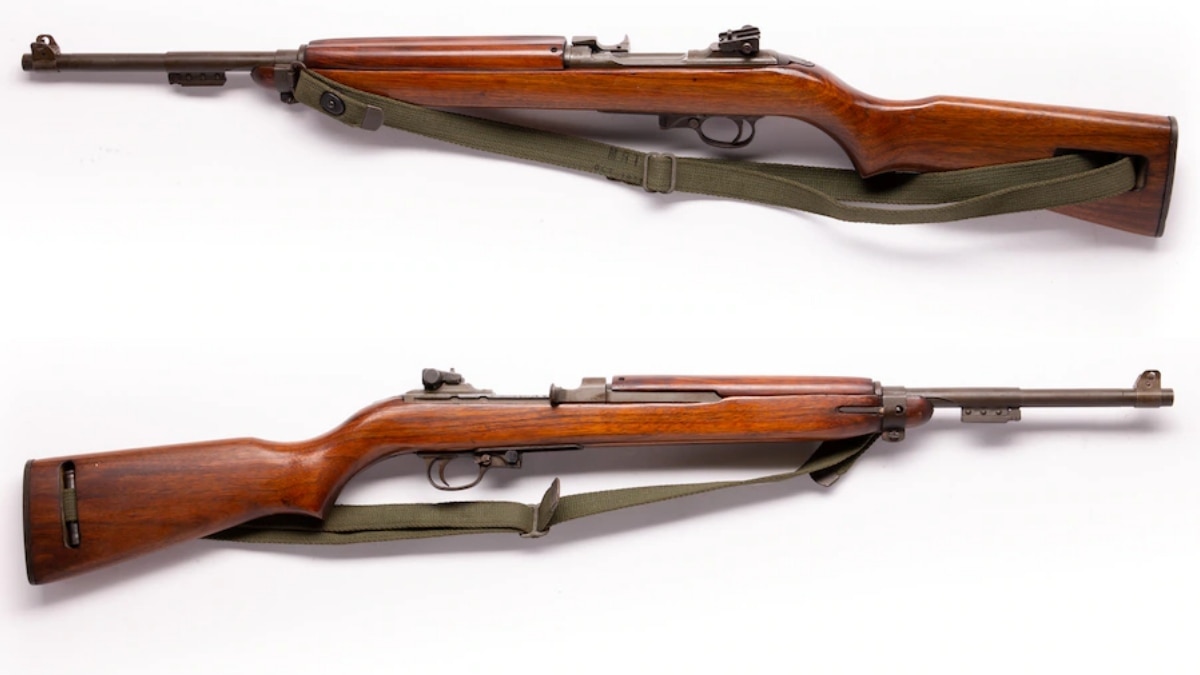
The M1 Carbine cost Uncle Sam $45 a pop to make during WWII, meaning about two of these compact light rifles could be bought for the price of each Garand.
Other Marines would carry a version of Gen. John Taliaferro Thompson’s submachine gun into combat. While in Europe at the time the M3 Grease Gun was seeing lots of use with the Army, the Tommy gun was still a favorite with Marine NCOs and came in handy when clearing caves and bunkers.
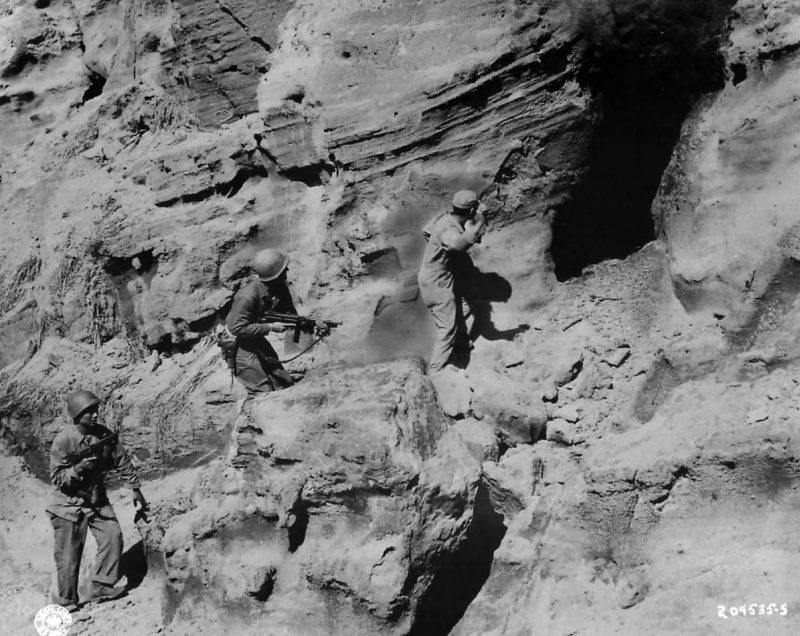
Marines clear cave on Iwo Jima with Thompson submachine guns
There were also light and heavy machine guns on Iwo, including two of John Browning’s offspring– the M1917 water-cooled .30 cal and its M1919 air-cooled little brother. Many machine gun operators, like officers, carried the M1911 .45ACP handgun, standard for the Marines through both World Wars.
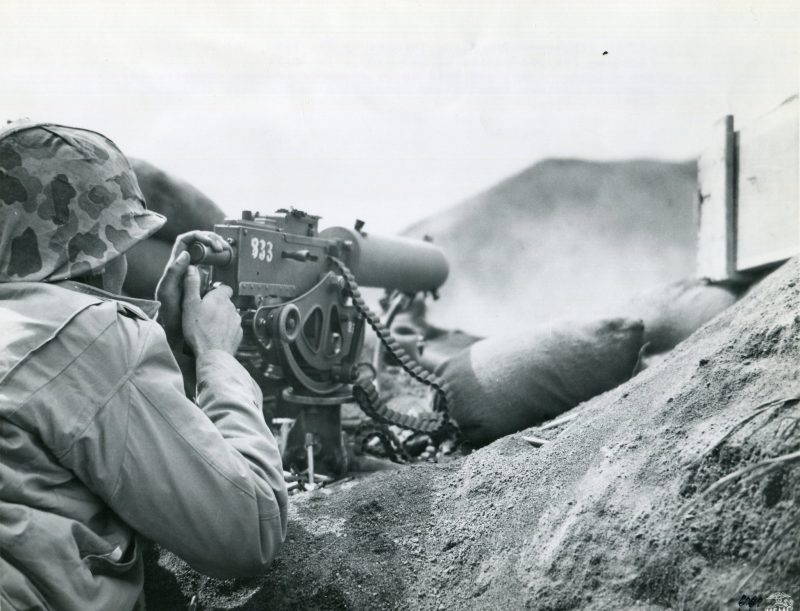
An M1917 water-cooled Browning machine gun in .30-06. The 103-pound gun used 250-round fabric belts and, though heavy, was famous for its use by Marines like John Basilone. Official caption: “RETURN FIRE—–Struggling forward by the Yard, the Marines fighting for possession of Iwo Jima, a strategic enemy island in the Volcano group, are held up by Japanese machine gunners. An American Marine immediately opens fire on the (enemy) with his .30 caliber weapon.”
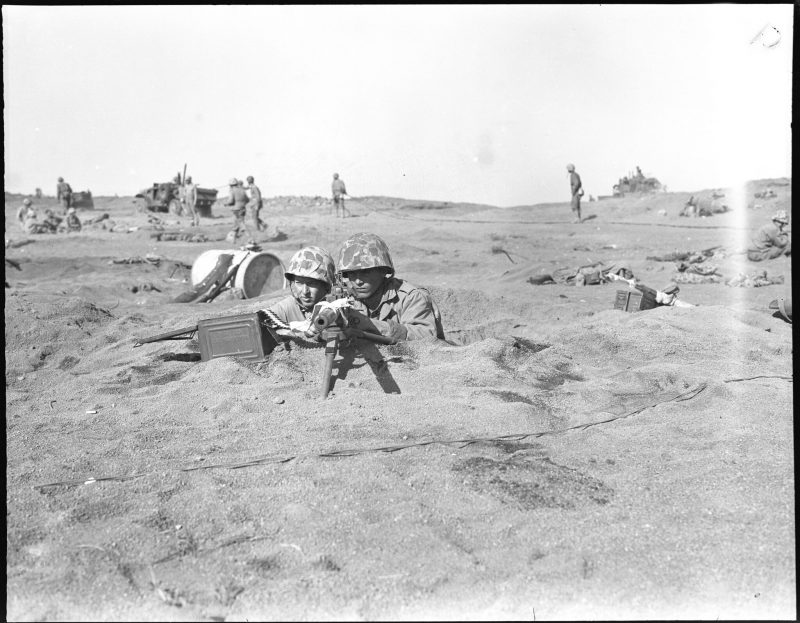
The business-end of the M1919. Although a lot lighter than the M1917, the A4 “light” variant in use on Iwo Jima still tipped the scales at 38-pounds, unloaded.
There was another LMG on Iwo of course, the 16-pound M1918 Browning Automatic Rifle. Unlike crew-served weapons, the .30-06 caliber BAR was carried and used by a single man. With a 20-round magazine, they had a cyclic rate of fire of about 500 rounds per minute as long as the mag held out.
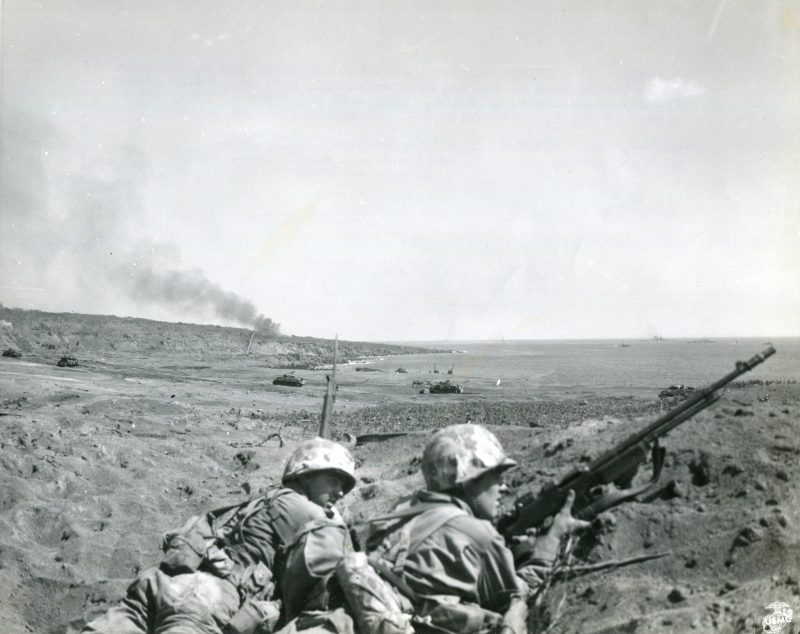
“FAITHFUL AND WAITING—-While a gigantic artillery and tank battle rages behind them on the Iwo Jima beachhead, Marines (left to right) PFC Joseph de Blanc, of Union, Maine, and PFC Frank Hall, of Reed W. Virginia, faithfully wait for orders in a shell hole.” Note the M1918 Browning Automatic Rifle (BAR).
In use with Marines since the Great War in France, there were also several pump-action 12-gauge scatterguns on Iwo Jima and elsewhere across the Pacific. As noted by Bruce Canfield, Marine divisions in WWII were recommended at least 490 shotguns each and bayonet-equipped Winchester M97 and M12 shotties were present in just about every landing across the Pacific. These were fed with brass-hulled shells often carried in old grenade pouches.
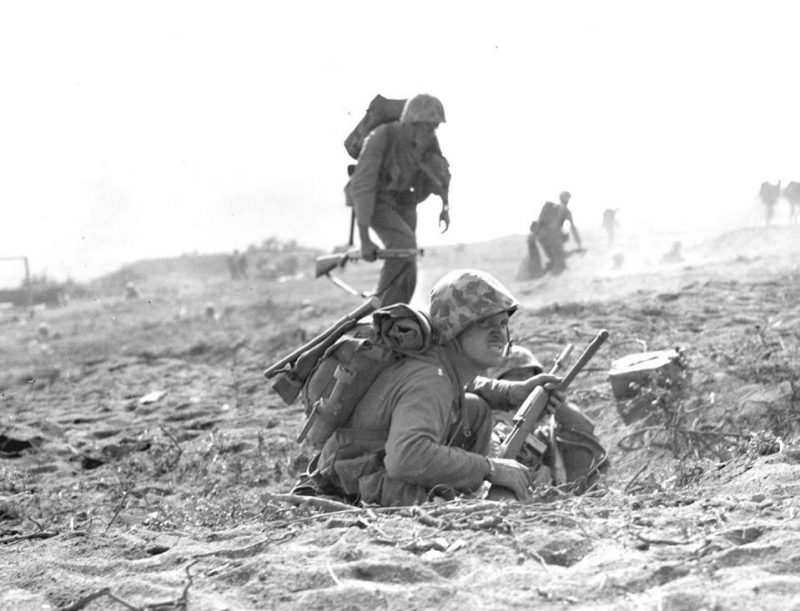
“GOING INLAND— Determination written on their countenances, Marines start the drive to the interior of Iwo Jima. Running at a crouch, they dart across the table and in the shadow of Mount Suribachi, taking advantage of the scant protection offered by small rises in the volcanic sand.” Note the M1 Carbine of the Marine in the foreground, with a rifle grenade attachment installed, and the Devil Dog with a Winchester Model 12 trench gun in the background.
There were other, more dramatic weapons as well.
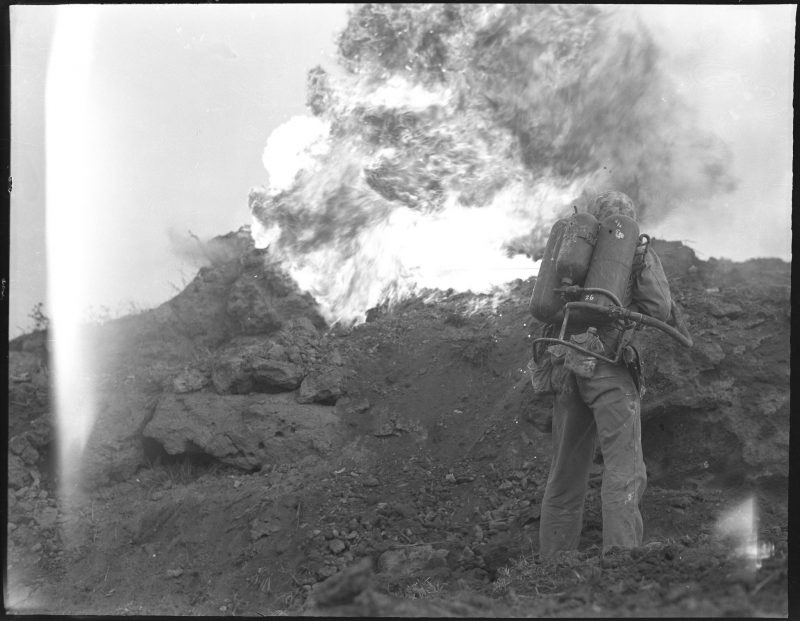
Flamethrowers were also useful in routing the defenders from the honeycomb of underground tunnels and bunkers on the island.
Marine Hershel “Woody” Williams, the last living Medal of Honor recipient from the Pacific War, carried a 70-pound flamethrower on Iwo Jima and used it to take on a network of reinforced concrete pillboxes by himself. He is currently 96 years old. In all, the Medal of Honor was presented to 22 Marines and five Sailors for their actions on Iwo Jima, many of those given posthumously. Adm. Chester Nimitz observed after the hellish battle that, “uncommon valor was a common virtue.”
In addition to flamethrowers and guns, the Marines also had their war dogs with them.
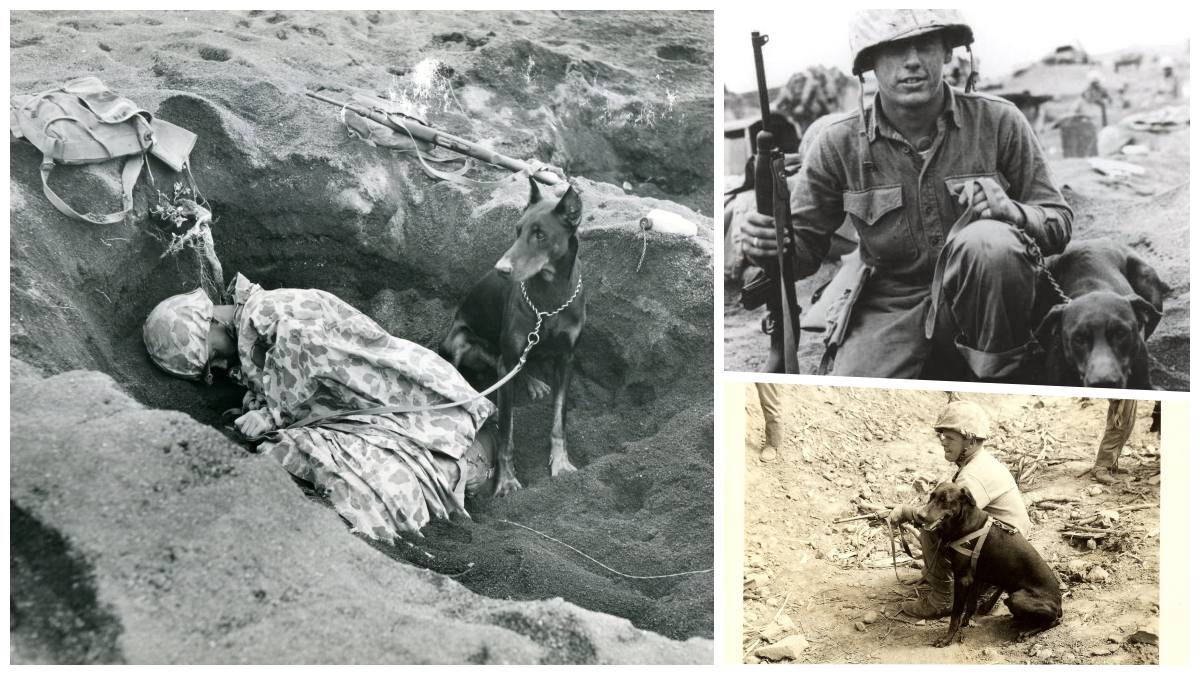
“Teams like this eliminated many (enemy) snipers who played possum in blasted pillboxes,” notes the USMC Archives. Note the handlers in each case are armed with an M1 Carbine, a handy item when minding a canine partner.
The Marines brought M4 Sherman tanks, rocket-carrying IHC M-2-4 trucks, and artillery as well, although it was often bogged down in the ash.
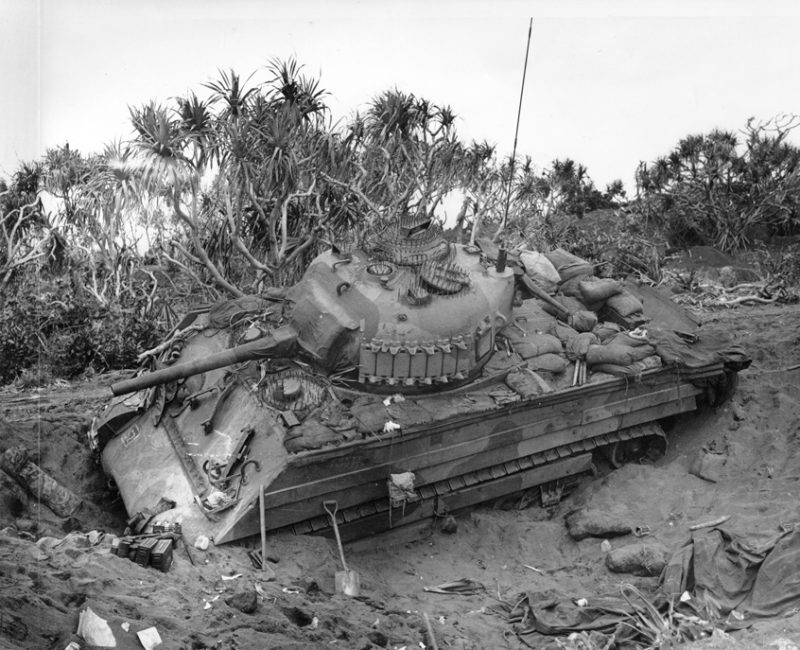
Photo caption: “Iwo Jima, February 21, 1945. Burrowed in the Sand: A Marine medium tank that couldn’t navigate the soft volcanic sand on Iwo, is track deep in a pit off the beach. This loose sand of the island proved an asset to the Japanese defenders.”
By February 23, the Marines had famously planted the American flag– twice– on Suribachi and Associated Press photographer Joe Rosenthal’s immortal photo of six Marines raising the ensign borrowed from a beached Navy LST and mounted to an eight-foot-long piece of pipe went on to be perhaps the most famous Marine photograph.
The image was later used for the Marine Corps War Memorial at Arlington to honor all the Marines who have died for their country since 1775.
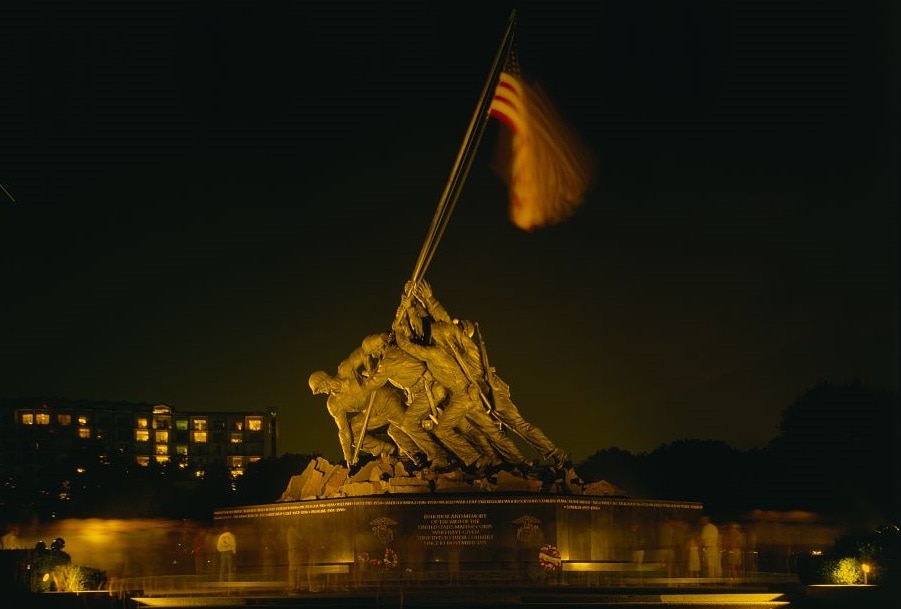
Nighttime view, east elevation – United States Marine Corps War Memorial, Marshall Drive, Arlington, Arlington County, VA (Photo: Library of Congress)
In all, the Navy and Marines suffered over 26,000 casualties in capturing Iwo Jima, with some units losing as much as half of their strength. The campaign is often characterized as the costliest battle in the history of the Corps.
Was it all worth it? On March 4, 1945, just three weeks after the Marines first landed on Red and Green Beaches and while pockets of resistance were still being rooted out, the first damaged B-29 landed on the island. In all, some 2,400 bombers made emergency landings on the Marine-held island before the end of the war with the Air Force noting “this figure represented an estimated 26,961 flight crewmen, many of whom would have perished at sea without the availability of Iwo Jima as a safe landing strip.”
One B-29 pilot reportedly said, “Whenever I land on this island, I thank God for the men who fought for it.”
For more reading on the Iwo Jima campaign visit the official Navy Historical Command website or consult Col. Joseph Alexander’s text, Closing In: Marines in the Seizure of Iwo Jima at the website of the U.S. Marine Corps History Division.
The post The Battle for Iwo Jima at 75: The Guns They Carried appeared first on Guns.com.
